The Noctua NH-U12A CPU Cooler Review: Big Performance in a Small Space
by E. Fylladitakis on July 11, 2019 12:30 PM EST- Posted in
- Cases/Cooling/PSUs
- Noctua
- CPU cooler
The Noctua NH-U12A CPU Cooler
Noctua designed the NH-U12A to be a high performance CPU cooler, yet not too large or too expensive. The use of 120 mm fans allows the NH-U12A to be compatible with more cases and a bit easier to install as well, while it also reduces the manufacturing cost of the cooler a little. Overall, the NH-U12A is compatible with most of the motherboards and processors released in the past several years, including LGA 2011 and LGA 2066 processors. The only processor socket of note that it's not compatible with is AMD's socket TR4 for Threadripper processors; these large processors require a matching larger base, and Noctua has the NH-U12S TR4-SP3 specifically for that processor.
Physically, the NH-U12A is relatively simple. It is a single tower cooler, with the array of fins floating above a small base and relying on heatpipes to transfer the thermal energy away from that base and to the main body of the cooler. Despite the 120 mm fan size, the NH-U12A is not exactly compact – it is short enough to fit inside the majority of ATX-compliant cases, but the fin array is thick and the presence of two 120 mm fans makes the cooler even wider. Even though Noctua made sure that the NH-U12A will stay clear of the PCI Express slots, the cooler will cover a significant portion of the motherboard and is very likely to hang over the RAM slots on many boards, limiting RAM height on these slots to 42 mm.
Noctua claims that the NH-U12A brings 140 mm cooler performance in 120 mm size. We can see why, as the array of fins is significantly wider than that of the NH-U12S, a cooler that the company introduced as a top-tier 120 mm cooler and even made a Threadripper-specific version of it. Aside from the wider array of fins, the cooler has seven heatpipes, accelerating heat transfer even further. The heatpipes are made of copper but are nickel-plated. The joints are all soldered, ensuring maximum thermal transfer and mechanical cohesion.
Due to the dense fin array, Noctua’s engineers had to optimize air pressure and went with two fans instead of one. The fans used are the company’s own 120mm NF-A12x25 fans, which combine airflow with good air pressure, making them ideal for fan speed controlled CPU coolers. Still, it appears that the very dense array of fins on the NH-U12A forced the designers to use two fans in order to maintain viable airflow levels, at least when the speed of the fans is low.
The base of the cooler that makes contact with the processor is split into two parts. The bottom half of the base is made out of nickel-plated copper, maximizing the heat transfer rate from the CPU to the heatpipes. It is extremely well machined, perfectly flat and smooth. The top half serves only as a mechanical support and is made out of aluminum, while the mounting bracket is nickel-plated steel.


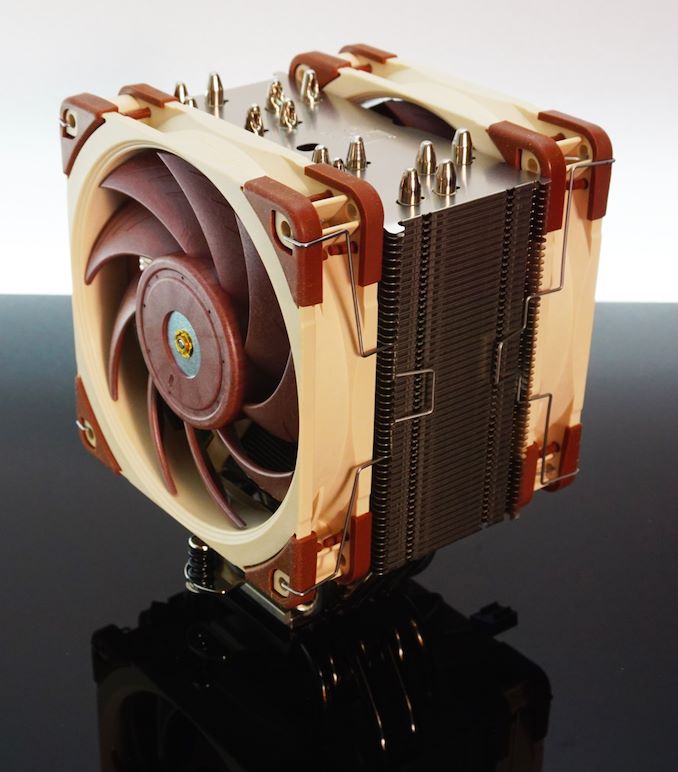
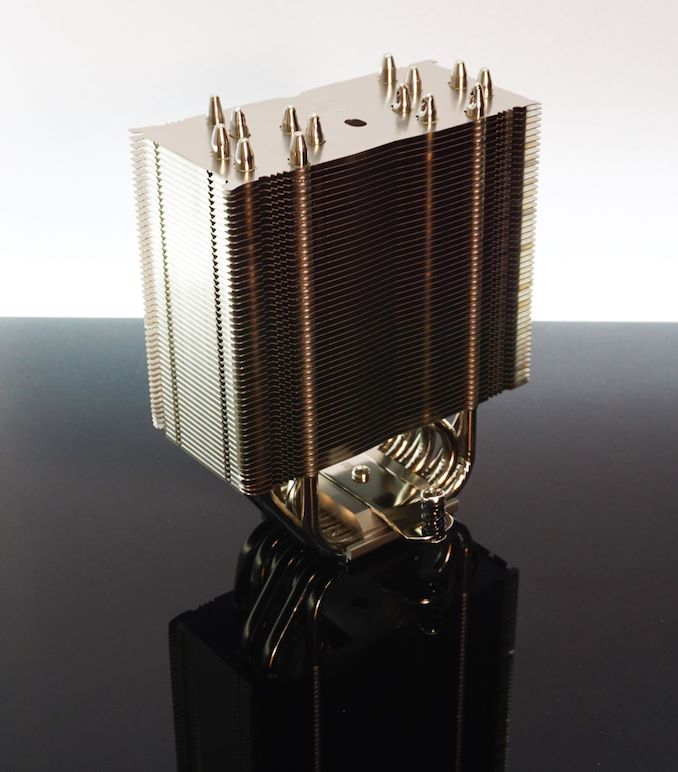
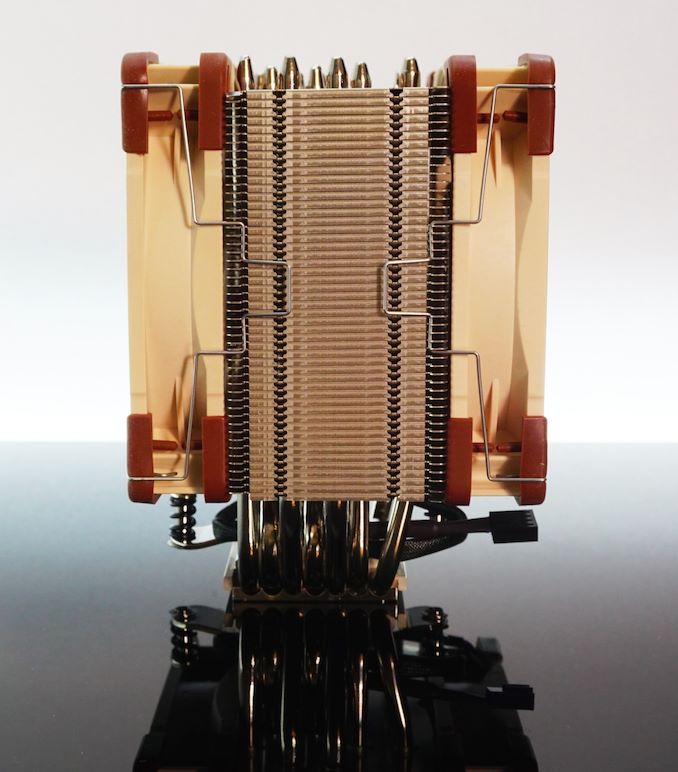
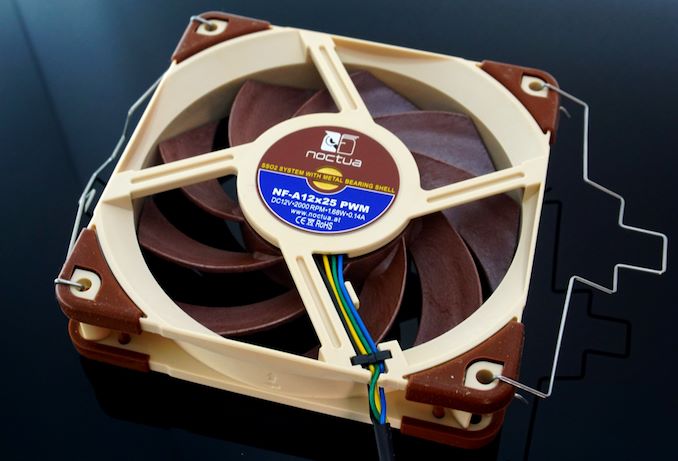
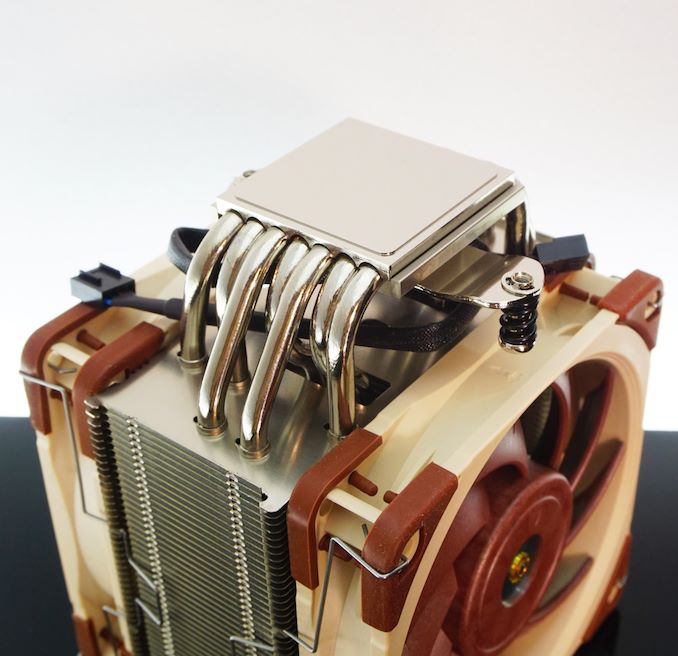








68 Comments
View All Comments
Soulkeeper - Friday, July 12, 2019 - link
What was the RPM on the fans ?Did they manage to spin at their rated 2000rpm during the testing ?
Ryan Smith - Friday, July 12, 2019 - link
https://images.anandtech.com/graphs/graph14621/111...We reached 1920 RPM, which is well within the manufacturer's margin of error for the fans.
sonny73n - Friday, July 12, 2019 - link
This stupid cooler is way overpriced and outdated. Nickel does not transfer heat better than copper. Why 2 fans? They’re only mere 2 inches apart, why not slap another 2 fans on it? Why Noctua always like to make heavy and big coolers? I’ll never support self-proclaimed “engineers” who has no clues about how to make better products.Korguz - Friday, July 12, 2019 - link
ok sonny73n if you think you can design something better for less.. then go do it...D@ Br@b($)! - Saturday, July 13, 2019 - link
He doesn't have to. There are already coolers with similar performance for less money.keyserr - Friday, July 12, 2019 - link
I would like a section for performance @ normalised sound, maybe at 32db, 33db, 34db etc because 7volts gives different rpms and noise.Arbie - Friday, July 12, 2019 - link
Scythe Mugen 5 for me too. When I last found comparisons of this against eg Noctua it offered equivalent results for much less money, and has been working great for me.But I'll probably just go with the Wraith cooler that will come with a top Ryzen 3000 chip. That does depend on 3950X tests when they surface, but current indications are that better cooling won't increase clocks.
This new AMD lineup will go a long way towards making high-end air - and of course any water loops - unnecessary. Those vendors must be getting nervous.
Qasar - Saturday, July 13, 2019 - link
" This new AMD lineup will go a long way towards making high-end air - and of course any water loops - unnecessary. Those vendors must be getting nervous. " how so ??Arbie - Thursday, July 18, 2019 - link
Because, as I indicated, increasing the cooling on Ryzen 3000 CPUs does not appear to increase their boost clocks. I had certainly hoped otherwise. Beyond that, very few people will manually overclock Ryzen 3000 because that achieves nothing over PBO, except to waste power all the time.So why go to premium air? And why even consider water? Except on Intel, but any vendor dependent on sales of those chips ought to be very nervous - as I said. The niche markets involved are getting smaller (for air) and much smaller (for water).
D@ Br@b($)! - Saturday, July 13, 2019 - link
+1